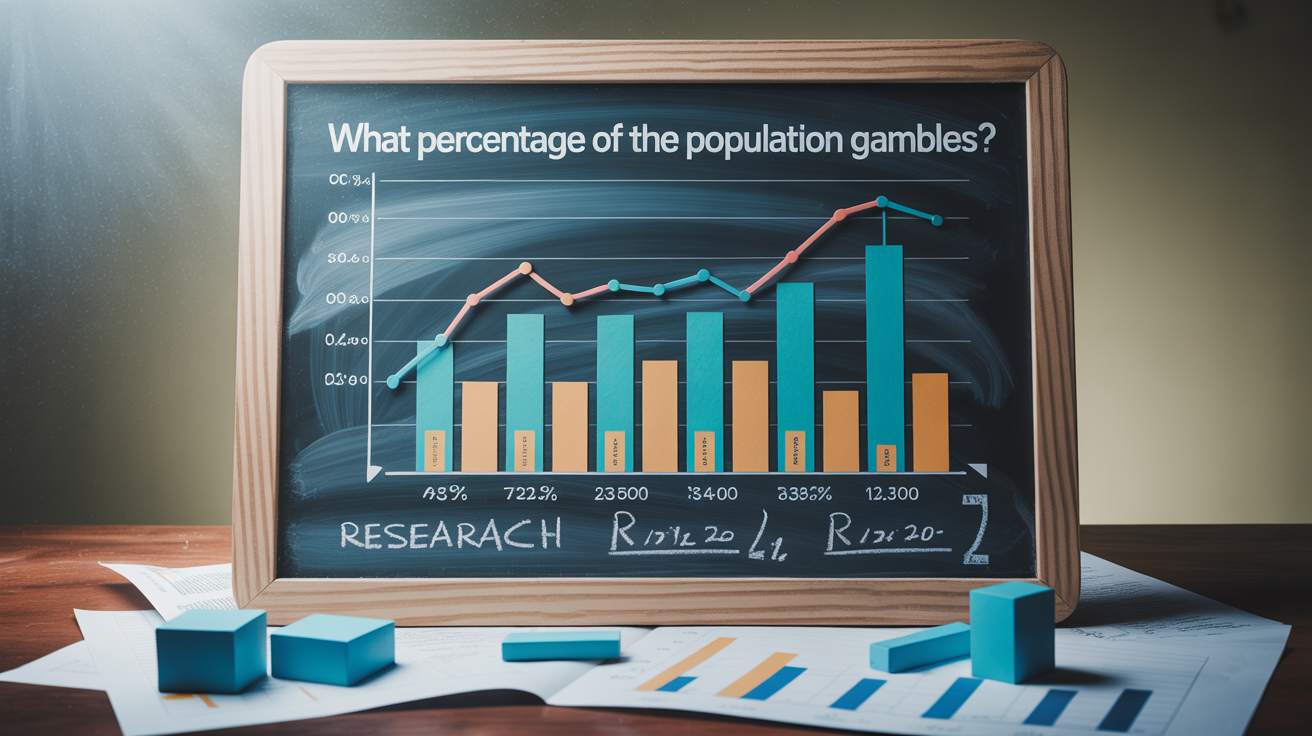Research: What percentage of the population gambles?

Guest Contribution – Let’s be honest- when you say someone gambles, you’re not just talking about folks grinding all night at the poker table in Vegas. It’s way broader than that. It’s the guy who grabs a lottery ticket with his morning coffee, the football fan throwing twenty bucks on his team, the aunt who still swears by bingo nights, or the friend who can’t resist spinning a few slots on their phone while waiting for the bus. Gambling is any time you put money on the line for the thrill of maybe turning it into more. And keeping track of who’s actually doing it matters. Why? Because it shows us how many people are chasing that buzz, how governments shape the rules, and even how it spills into things like taxes, mental health, and how communities deal with it all.
And here’s the kicker: gambling isn’t new. People were betting before casinos even existed- rolling bones, flipping coins, drawing straws. But the digital age put rocket fuel in the tank. Now, you don’t need a smoky room or a dealer in a bow tie; you need Wi-Fi. Online platforms turned what used to be a night out into something you can do on your couch in slippers. Sites like https://slotsspot.com/ cut through the jungle, pointing out which online casinos are actually legit so players don’t get burned.
Global gambling participation rates: How much of the world gambles?
Gambling isn’t some underground niche thing- it’s everywhere, baked into everyday life. You see it in the guy scratching off a lotto ticket at the corner store, the office pool for the big football game, or the crowds chasing jackpots in Vegas and Macau. And thanks to online casinos, the game is now in everyone’s pocket. The real question is: how many people actually gamble worldwide?
| Region / Source | Estimated Participation Rate | Key Notes |
| Global Average (WHO, 2023) | ~26% of adults | About 1 in 4 adults placed at least one bet in the past year. |
| Europe (Gambling Commission & EU studies) | 30–40% | Lotteries and sports betting dominate, with online casinos booming fast. |
| North America (AddictionHelp, 2024) | 48–50% | Nearly half of adults gamble, with U.S. sports betting exploding post-2018 legalization. |
| Asia-Pacific (ScienceDirect, 2024) | 25–30% | Lotteries are king, but online slots and apps are climbing hard in India and the Philippines. |
| Africa (WHO estimates) | 15–20% | Mobile sports betting is taking over, fueled by smartphones. |
| Australia | ~70% | The world’s heavyweights in gambling, mostly lotteries and pokies, losing more per person than anywhere else. |
Look at those numbers and tell me gambling isn’t global. The bottom line? Gambling isn’t a side hustle for humanity- it’s a full-blown habit, and the numbers are still climbing like a progressive jackpot.
Gambling participation in the UK
In the UK, gambling is baked into daily life. You see it everywhere- scratchcards at the corner shop, a fiver on the weekend football acca, or a cheeky spin on an online slot while waiting for the kettle to boil. According to the UK Gambling Commission’s 2023 stats, about 44% of adults had a flutter at least once in the year. Most keep it small- lottery tickets and low-stakes bets- but the real action is shifting online. These days, almost everyone gambles with their phone in hand, and mobile apps mean you can drop a bet in seconds. Football and horse racing still run the show, but with online casinos and slots climbing the charts, it’s clear the UK gambles more digitally now than it ever has before.
But it’s not all about flashing lights and fun. The UK runs one of the strictest regulatory regimes out there, and that changes how everyone gambles. Affordability checks, ad restrictions, and safer gambling tools are built into the system, whether players like it or not. Most folks gamble casually without issue, but there’s always that small slice- about 0.2–0.3%- who gambles beyond control and slide into problem territory, which keeps regulators busy. The UK market is really a mash-up of old-school habits and modern trends: bingo halls where grandma still gambles for a laugh, and booming online casinos and sports apps where the younger crowd gambles deep into the night.
Gambling participation in the US
The U.S. gambling story has gone into overdrive since the 2018 Supreme Court decision that blew the doors open on sports betting. Almost half of American adults now gambles in some form every year, with lotteries still topping the charts. But the real star of the show? Sports betting. It’s everywhere- legal in more than 30 states, plastered across stadiums, and backed by pro leagues. Vegas and Atlantic City still pull crowds, but online casinos in legal states are giving them a serious run. Slots, poker, blackjack- every corner of the casino floor now lives on your phone, and even esports gambles are sneaking onto the radar as the new kid on the block.
The catch is America’s patchwork of laws. One state lets you gambles on apps, in casinos, and at sportsbooks on every corner, while the next bans it all outright. Nevada and New Jersey are flooded with action, while other states barely register. Problem gambling is a bigger deal here too, with 1–2% of adults who gambles crossing into dangerous territory- roughly double the UK rate. Even so, gambling has cemented itself as mainstream American entertainment. Billions are wagered every year, and the line between a casual weekend bet and hardcore play keeps getting blurrier. Whether someone gambles in Vegas on the slots or fires off bets on their phone, the U.S. scene is only getting hotter.
Gambling in Europe and other regions
You’ve got Italy and Spain where betting is basically part of daily life. People grab a scratch card with their morning coffee, place a fiver on the weekend football, then log into an online slot before bed. And because the laws are tight and the regulators keep casinos on a short leash, folks there play a lot but usually feel safer doing it. According to EU numbers, nearly half the population in spots like Italy or the Spain gambles at least once a year. Head north and the story gets even louder: Sweden and Finland practically live online. With fast internet and zero stigma, casino sites there are as normal as ordering food delivery. But swing east and you see the brakes come on – countries with stricter cultural rules or fewer licensed casinos show way lower participation. It’s not that people don’t play, it’s just pushed underground.
Outside Europe, the vibe shifts again. Asia’s got its heavyweights – Macau is basically Disneyland for gamblers, and Singapore runs some of the sleekest casinos you’ll ever step into. But beyond those hubs, most of Asia is locked down, which splits the scene between high-rolling resorts and outright bans. Australia, though? Different league. Aussies bleed money on gambling more than anyone else on the planet. Pokies are everywhere – pubs, clubs, even gas stations – and they love ’em. New Zealand’s not far behind either. Over in Africa and Latin America, it’s all about the rise of mobile. A cheap smartphone and data plan are enough to dive into sports betting apps, and that market is exploding. They might not have Europe’s sheer volume yet, but the growth is insane – like watching a jackpot meter spin out of control.
Who gambles more? Demographics and behavior
Here’s the thing: not everyone gambles the same way. Younger adults, especially the 18–34 crowd, are basically glued to their phones. They’re hammering slots, placing bets on esports, and chasing live odds while they scroll TikTok. It’s quick, flashy, and fits right into their digital lifestyle. The older crowd still plays, but they stick to the classics: lotteries, bingo nights, or maybe a trip to the local casino when the mood hits. And yeah, there’s a gender gap. Men show up heavier in sports betting and poker rooms, where the bragging rights matter just as much as the money. Women lean more toward bingo, scratch-offs, and casual slots – lower stakes, steady fun, no chest-thumping needed.
Money adds a whole other twist. High earners gamble more often, but they treat it like a night out – dinner, drinks, a few hundred on the tables, no stress. They’re not betting the rent. Lower-income players are where it gets risky. Chasing that “one big win” can spiral fast, and that’s where problem gambling shows up. Studies say 1–3% of gamblers fall into that category, often tied to high-frequency play and games built to sting, like volatile slots that pay nothing ten times in a row before dropping a massive hit. Bottom line? Who gambles depends on your age, wallet, and habits. Some play for fun, some for the thrill, and some get burned chasing luck that doesn’t show up. The patterns are clear, but the stories behind them are what make gambling such a raw, unpredictable part of human behavior.
Conclusion
After digging into the stats, it’s pretty obvious: gambling isn’t some underground hobby anymore, it’s straight-up mainstream. Around one in four adults worldwide is tossing chips on the table in one way or another. Some keep it light with a lottery ticket at the corner shop, others go all-in with a Vegas weekend, and plenty just pull out their phones and spin a few reels on the couch. The hotspots are clear- Australia, the UK, and the States lead the charge- while other regions are racing to catch up thanks to online casinos blowing the doors wide open. It’s not just a pastime anymore; it’s a monster industry, with billions changing hands every single year.
________________________________________________________________________________________________________________
Advertisements placed in our Guest Contribution sections are in no way intended as endorsements of the advertised products, services, or related advertiser claims by NewsroomPanama.com, the website’s owners, affiliated societies, or the editors. Read more here.





